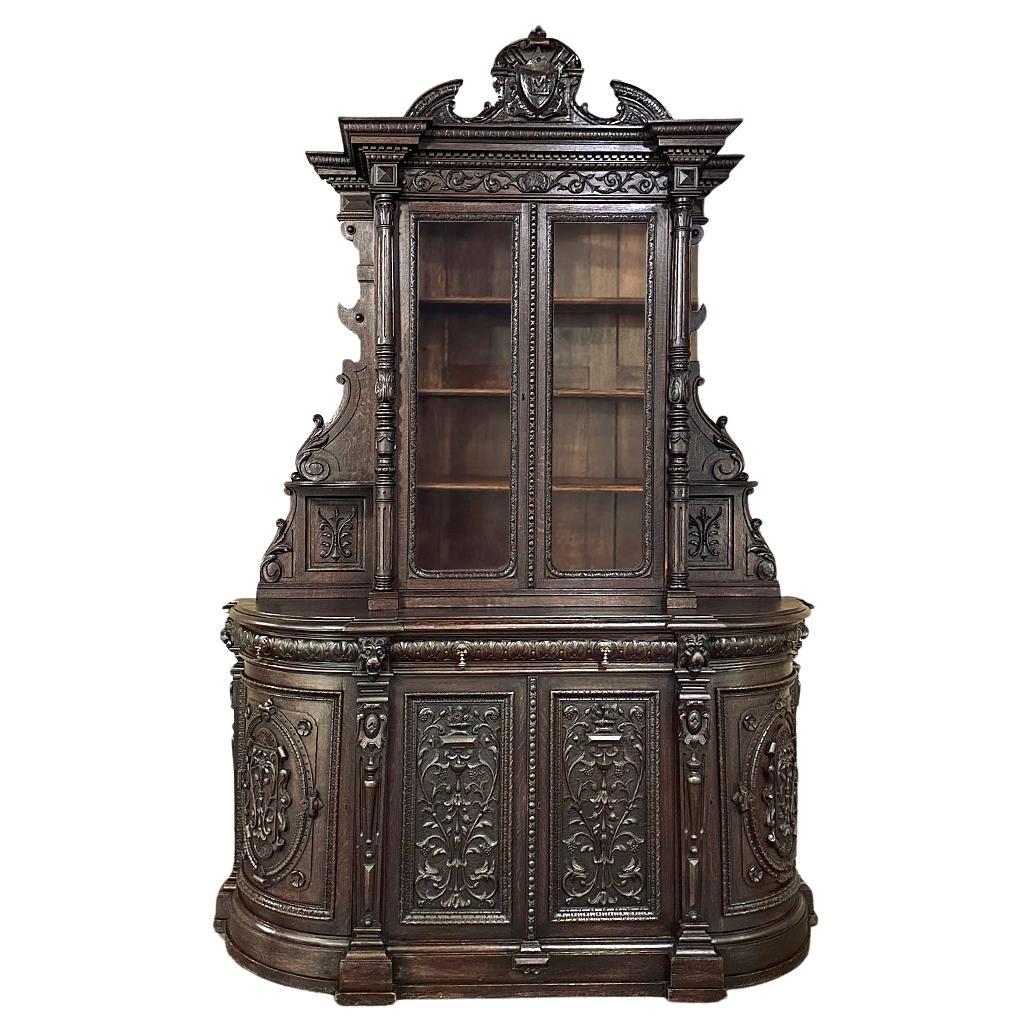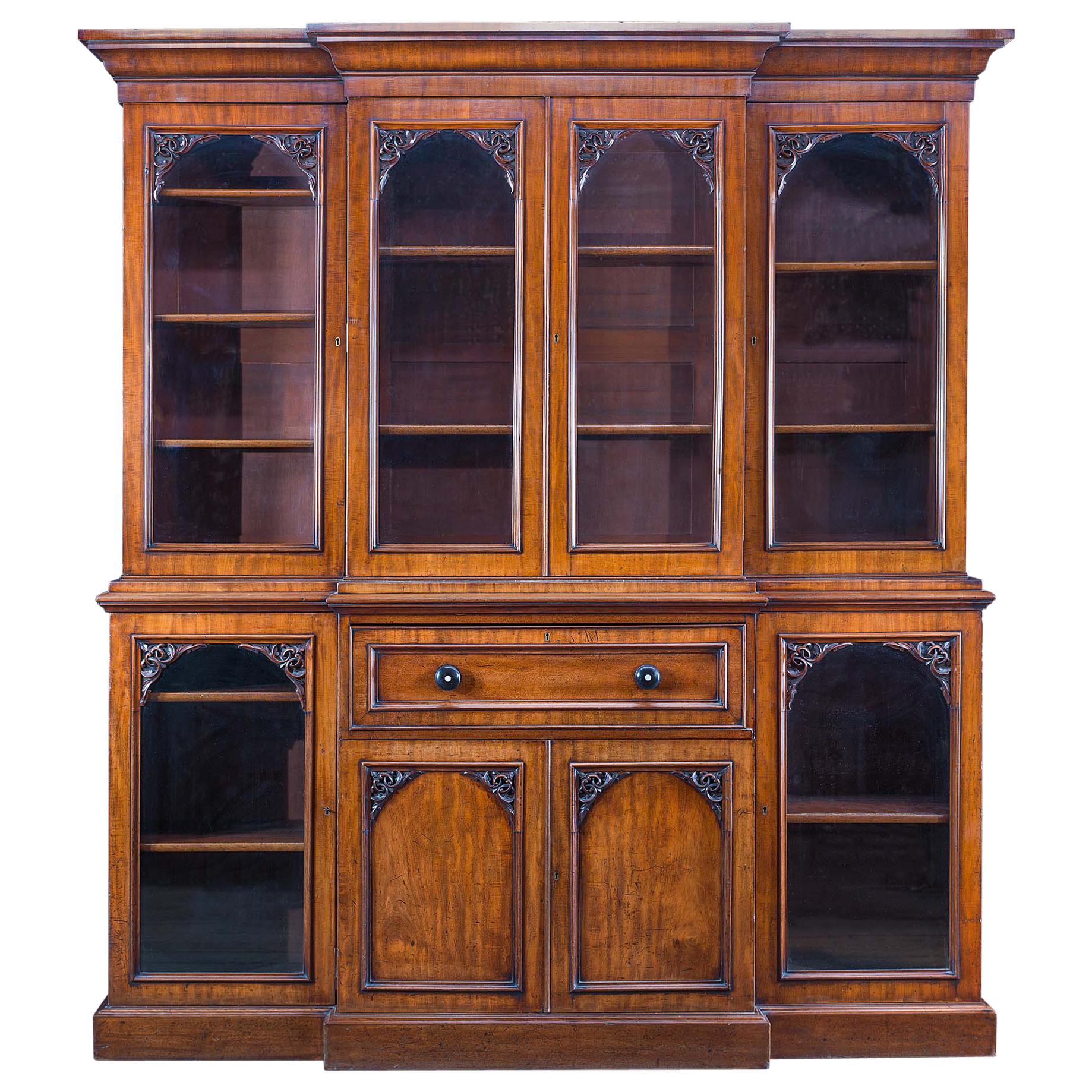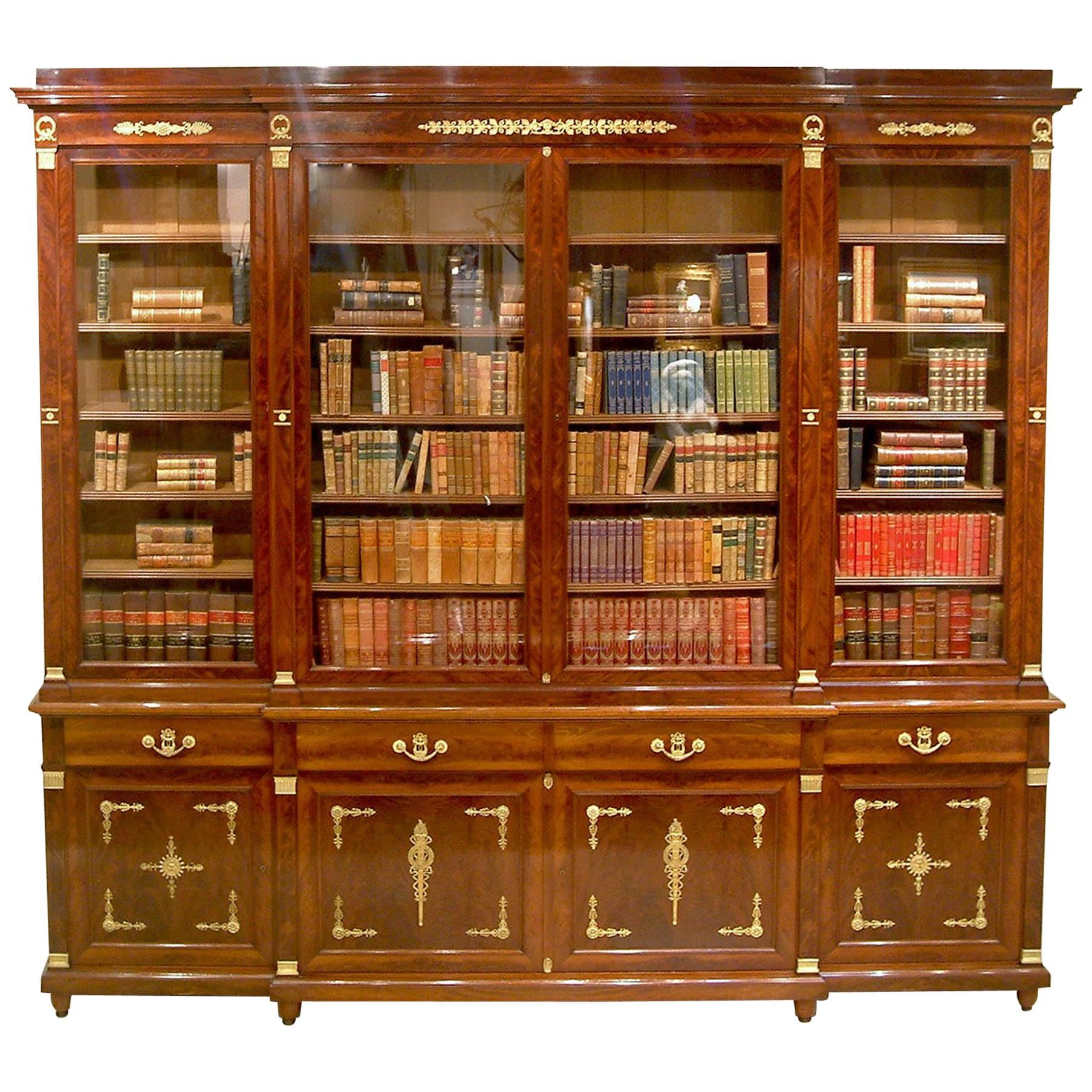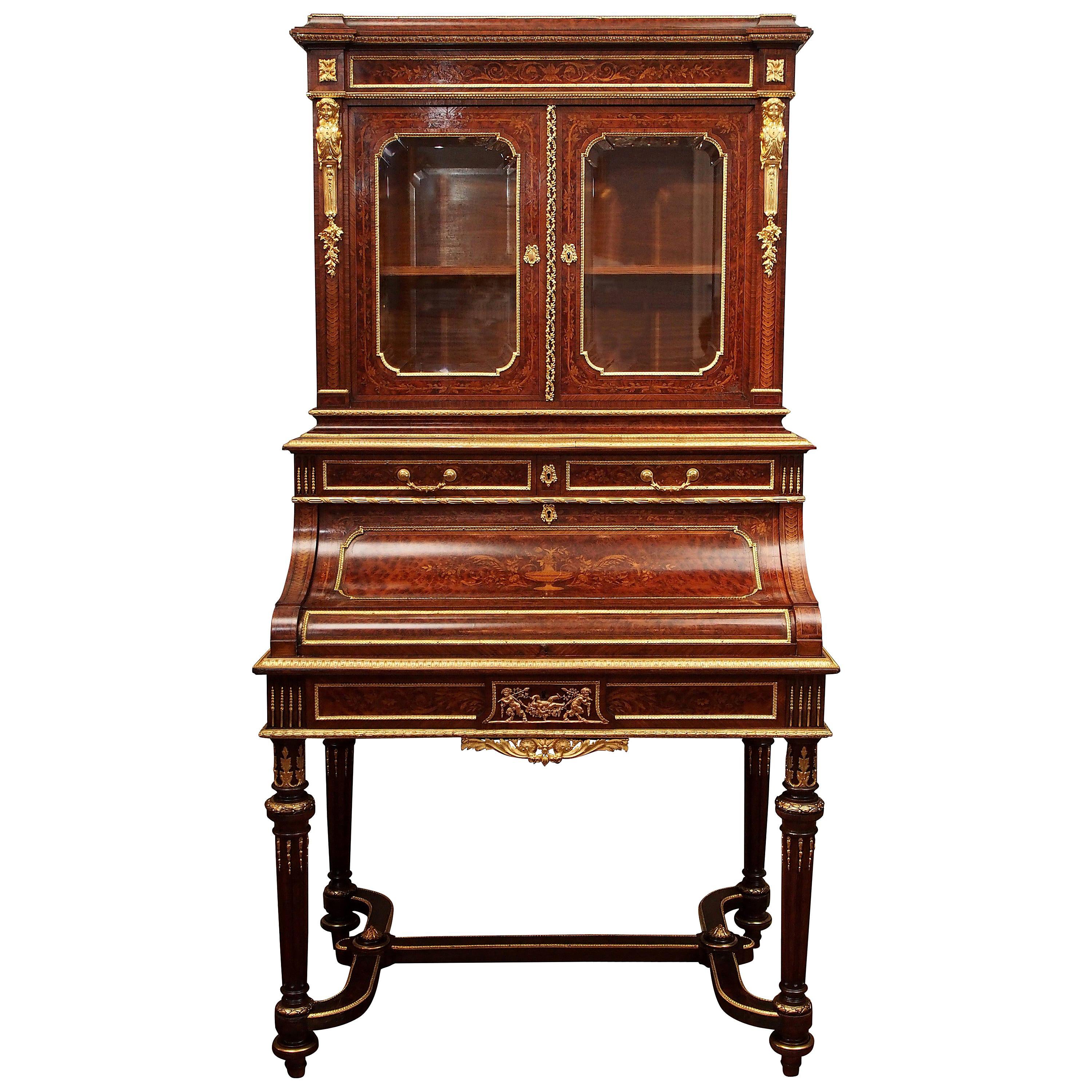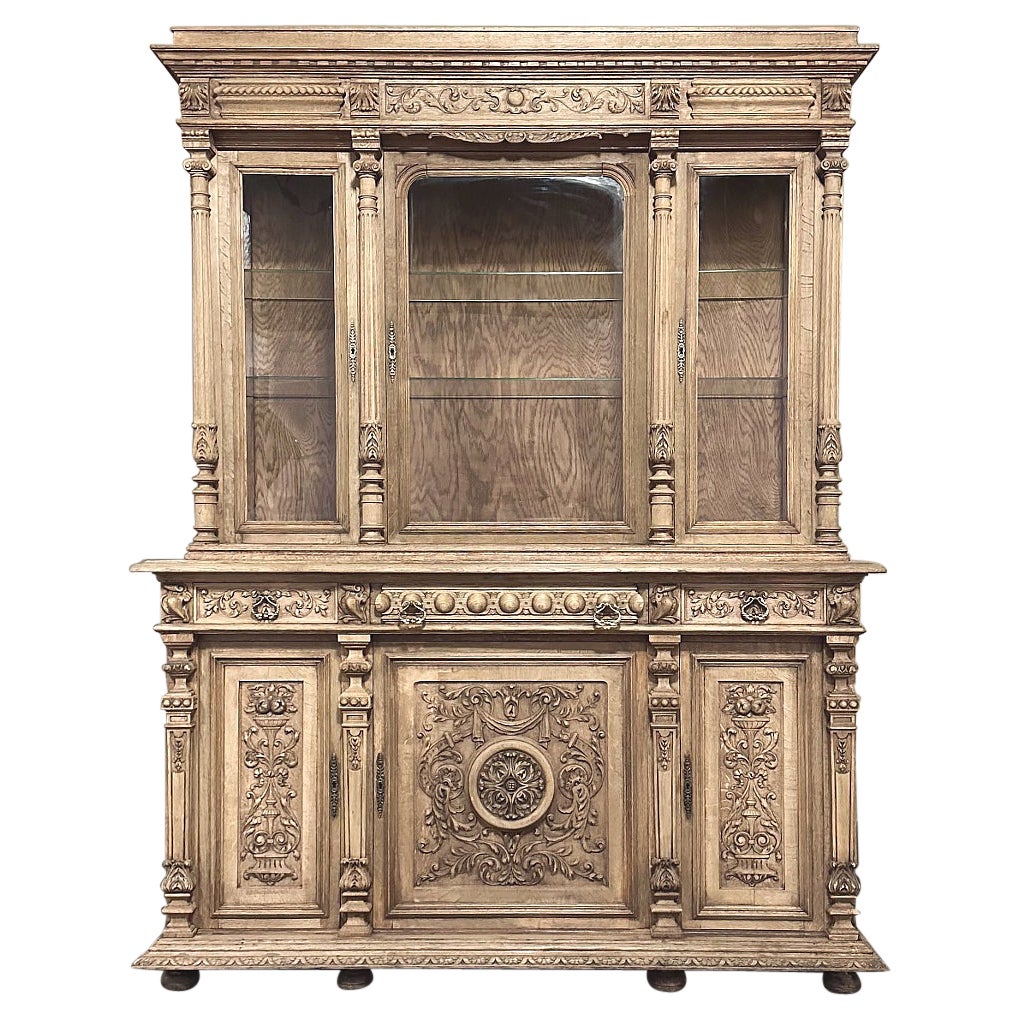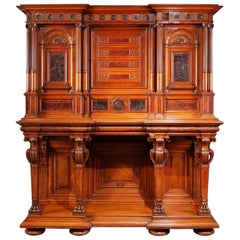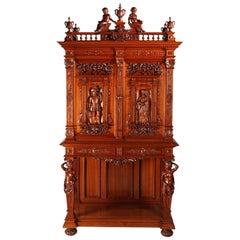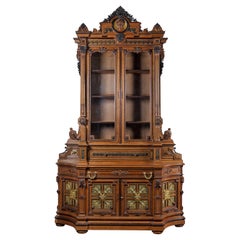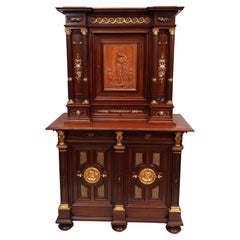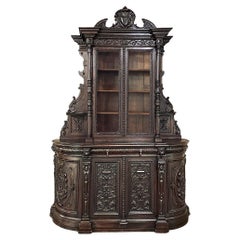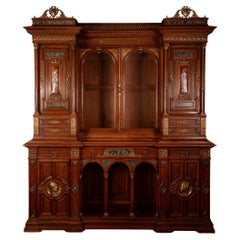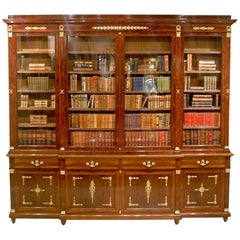Items Similar to Exceptionel Bookcase Forming Desk, by G. Grohé, France, Circa 1860
Want more images or videos?
Request additional images or videos from the seller
1 of 12
Exceptionel Bookcase Forming Desk, by G. Grohé, France, Circa 1860
$1,023,558.37
£757,305.25
€850,000
CA$1,415,251.64
A$1,553,769.79
CHF 810,605
MX$18,802,777.53
NOK 10,159,675.60
SEK 9,573,085.54
DKK 6,471,923.75
About the Item
Exceptional neo Renaissance bookcase forming desk. This monumental piece consists in a lower part forming drop-front desk supported by two pillars with drawers. The lateral parts each open with a moulded door. The bookcase occupies the upper part, opening by four windows separated by carved semi-columns finishing in Corinthian capitals. The whole is surmounted by a large pediment adorned with chimera and a female head. The ornaments is inspired by the Renaissance and consists mostly in carved foliate, chimera, griffins and phantasmagorical masks, what makes this piece not only a masterpiece of architecture, but also of sculpture.
This exceptional piece was sold when the Grohé factory completely stopped its production, in 1884, in Paris.
Guillaume Grohé (1808-1885) born in the Grand Duchy of Hesse-Darmstadt came to settle in Paris in 1827. With his brother Jean-Michel, he run a successful company named “Grohé Brothers” featuring furniture and objects of art, and presenting successfully works at the Exhibition of the Products of Industry in 1834. His success was as well as fast as substantial. Guillaume received the Legion of Honour in 1849 and was later promoted to officer of that order. In 1861, his brother retired from business, leaving Guillaume alone at the head of the company. With no successor, the company ceased trading in 1884. Supplier of King Louis XVIII (Louis XIV style console, National Exhibition of 1844, a Renaissance style Ebony museum cabinet, 1844), King Louis-Philippe, the Emperor Napoleon III (mahogany dining room, Palace Saint-Cloud, 1855; mahogany furniture, Compiègne Palace, Renaissance style mahogany furniture at the Palace of Fontainebleau, 1859), and after 1862, he supplied Queen Victoria. Specialized in the making of furniture of various styles, the Duke of Aumale commissioned him the furniture of the castle of Chantilly. He took part brilliantly and was also several times member of the jury at the Universal Exhibitions. According to the report of the jury for the 1878 Paris Universal Exhibition, Grohé is described, as “the undisputed master of the modern cabinet-making, was exhausted in respect of all forms of praise, as he won all the series of rewards.” Maxime Boucheron last quoted in an article in Le Figaro in 1884 that “Grohé was a true grand master of the art of the nineteenth century cabinetmaking. A career of over fifty years has filled our museums, our national palace with incomparable masterpieces. He assured the dominance of French taste in luxury furniture.”
- Creator:Guillaume Grohe (Cabinetmaker)
- Dimensions:Height: 129.93 in (330 cm)Width: 118.12 in (300 cm)Depth: 31.5 in (80 cm)
- Style:Renaissance (In the Style Of)
- Materials and Techniques:
- Place of Origin:
- Period:
- Date of Manufacture:circa 1860
- Condition:Wear consistent with age and use. For shipping:Dismountable set in several parts.
- Seller Location:PARIS, FR
- Reference Number:Seller: 528/241stDibs: LU3860328565122
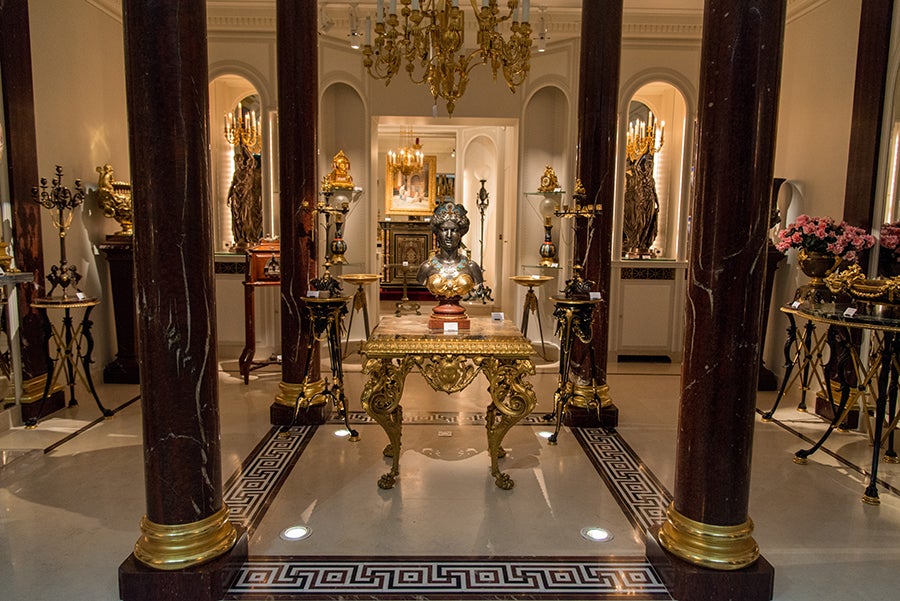
About the Seller
4.9
Vetted Professional Seller
Every seller passes strict standards for authenticity and reliability
Established in 1997
1stDibs seller since 2018
87 sales on 1stDibs
Typical response time: <1 hour
Associations
International Confederation of Art and Antique Dealers' Associations
- ShippingRetrieving quote...Shipping from: Saint Ouen, France
- Return Policy
Authenticity Guarantee
In the unlikely event there’s an issue with an item’s authenticity, contact us within 1 year for a full refund. DetailsMoney-Back Guarantee
If your item is not as described, is damaged in transit, or does not arrive, contact us within 7 days for a full refund. Details24-Hour Cancellation
You have a 24-hour grace period in which to reconsider your purchase, with no questions asked.Vetted Professional Sellers
Our world-class sellers must adhere to strict standards for service and quality, maintaining the integrity of our listings.Price-Match Guarantee
If you find that a seller listed the same item for a lower price elsewhere, we’ll match it.Trusted Global Delivery
Our best-in-class carrier network provides specialized shipping options worldwide, including custom delivery.More From This Seller
View AllNeo-Renaissance Cabinet by G.F. Quignon, Universal Exhibition of Paris 1889
By Frederic Gustave Quignon
Located in PARIS, FR
Presented at the Universal Exhibition of Paris in 1889
Important sculpted and engraved natural wood, patinated bronze and Griotte de Campan red marble inlaid Neo-Renaissance style cabinet.
The upper part is composed of a frieze of bronze medallions separated by triglyphs and supported by ribbed columns with Corinthian capitals. There are eight of these columns paired at the front and two simple columns at the rear. The facade presents an alternation of bronzes in niches and cartouches, of marble slates in cartouches sometimes flanked by palmettes, and of engraved motives of laurel and foliage scrolls. The upper part opens with three leaves and three mobile compartments. The belt carved with acanthus leaves opens with two drawers. This cabinet is supported by four richly sculpted tapered feet ending with claws. Four fluted pilasters are inscribed in the moulded back as counterparts. The whole ensemble stands on a moulded plinth and eight rounded feet.
Neo Renaissance Cabinet...
Category
Antique 1880s French Renaissance Cabinets
Materials
Marble, Bronze
$130,052 Sale Price
20% Off
Renaissance Style Wooden Cabinet Attributed to H.A. Fourdinois, France, 1893
Located in PARIS, FR
A wooden cupboard, elaborately carved throughout, dated "1893" on the crest and attributed to H.A. Fourdinois. The upper section with a pair of cherubs at the center of a balustrade ornamented with two-handled urns, two architectonic doors below, carved with lady and gentleman in niches surrounded by extensive carving with classical motifs. The lower section with two drawers above a standing female caryatid support at each front corner. The all reposing on four gadronned round feet.
The Fourdinois company was founded in 1835 by Alexandre-Georges Fourdinois (1799-1871). The Universal Exhibition held in London in 1851 was undoubtedly their first great artistic and public success. Winning the Great medal for a neo-Renaissance buffet...
Category
Antique 1890s French Renaissance Cabinets
Materials
Wood
$15,895 Sale Price
40% Off
Wooden & Enameled Display Sideboard Attributed to H.A Fourdinois, France, c1867
Located in PARIS, FR
Important two-tiered sideboard attributed to H.A. Fourdinois made in natural and carved wood : the lower part made up of four panels, two concave ones and two doors, richly ornated with a polychrome enameled floral decoration and gilt bronze plaques.
A large dual drawer is surmounted by the upper part of the sideboard, opening with two glazed doors, framed by detached columns. The entire unit is topped with a pediment onto which a female bust is carved in relief within a medallion on a gilt background.
With a matching set of twelve chairs.
The Forney library in Paris preserves order registers of the Fourdinois as well as sketches books and pictures representing pieces of furniture made by the Fourdinois workshops. In this documentation, some elements enable us to link this sideboard with Henri-Auguste Fourdinois’ productions, such as the large scrolls linking the upper part to the lower part of the sideboard, as well as the detached columns carved at their lower third. (picture n°1 attached)
Notebook containing ink-sketches coming from the Fourdinois workshop shows a project for a pelmet, beautified with a centering trophy composed of a torch and a quiver within in a foliage wreath, this motif obviously reused by the Fourdinois on the central decoration of the panels of our sideboard. (picture n°2 attached)
The firm of Fourdinois, considered during the Second Empire as the greatest furniture manufacturer in Paris, was founded in 1835 by Alexandre-Georges Fourdinois (1799-1871). It was developped in the context of the Expositions Universelles. At the time, the firm already produces furniture of the Neo-Renaissance style, such as a dresser that won the Great Medal at the London Universal Exhibition of 1851. The son, Henri-Auguste Fourdinois (1830-1907), joined the firm in 1860 and will become head of the firm in 1867. The high quality of his designs was remarked at the Universal Exhibition in 1862, when the jury awarded him two medals « for Excellence of Composition and Execution ». Henri-Auguste, now sole in charge, brought the firm to the summit of its achievements at the 1867 Universal Exhibition in Paris by winning the Grand Prize for his stand. Apart from the commissions he executed for the « Mobilier de la Couronne », he also produced high quality furniture for the Parisian bourgeoisie. The firm is at its zenith during the years 1862-1880. At this time, it is considered as an example to follow for other cabinet-makers, whether they are French, British or American.
Through the quality of execution and the extreme care taken in the decoration of furniture, H.-A. Fourdinois was particularly appreciated by Napoleon III and Eugenie...
Category
Antique 1860s French Renaissance Sideboards
Materials
Enamel, Bronze
Neo-Renaissance Cabinet by P. Sormani and attr. to E. Lièvre, France, Circa 1870
By Paul Sormani, Edouard Lievre
Located in PARIS, FR
Signed twice on the lock P. SORMANI 10 rue Charlot Paris
Rare neo-Renaissance cabinet in carved wood and Portor marble, adorned with chiseled and gilded bronze.
The upper, part, surmounted by a frieze of posts and marble cabochons, consists of a central door decorated with a carved panel representing the birth of Venus, framed by two pairs of ringed and fluted columns with Corinthians capitals in gilded bronze revealing two doors with secret opening. Two drawers with lion’s head shaped handles and a central drawer decorated with tracery in gilded bronze complete the upper part of this cabinet.
In the lower part, two drawers on the belt with diamond...
Category
Antique 1870s French Renaissance Cabinets
Materials
Marble, Bronze
$65,507 Sale Price
38% Off
Renaissance Style "Four Seasons" Cabinet by M. Lerolle, France, Circa 1890
By Lerolle
Located in PARIS, FR
Signed " Meubles D’Art, M. Lerolle, Fabricant, 61, Rue des Sts-Peres. Paris "
Remarkable carved wood cabinet, richly sculpted in the Neo-Renaissance style, and inlaid with vert de m...
Category
Antique 1890s French Renaissance Revival Cabinets
Materials
Marble
Regence Style Wooden Display-Cabinet by C. Potheau, France, circa 1895
By Potheau
Located in PARIS, FR
Signed Constantin Potheau, ébéniste, Paris.
Measures: Height 275 cm (108,2 in., width 160 cm (63 in.);
Upper part depth 48 cm (18.8 in.) / inside 42 cm (16.5 in.)
Lower part dept...
Category
Antique 1890s French Régence Buffets
Materials
Wood
You May Also Like
19th Century French Renaissance Two-Tiered Bookcase ~ Bibliotheque
Located in Dallas, TX
19th Century French Renaissance Two-Tiered Bookcase ~ Bibliotheque is an impressive example of the refined Renaissance style, sometimes referred to as Henri II, with architecture tha...
Category
Antique Mid-19th Century French Renaissance Bookcases
Materials
Brass
Large 19th Century Victorian Breakfront Bookcase with Integral Secretaire
Located in London, GB
A very fine and large Victorian mahogany breakfront bookcase and secretaire. The upper part has four compartments, the doors of ...
Category
Antique Mid-19th Century English Early Victorian Bookcases
Materials
Mahogany
Édouard LIÈVRE, Paul SORMANI, Neo-Renaissance ceremonial sideboard and buffet
By Paul Sormani, Edouard Lievre
Located in SAINT-OUEN-SUR-SEINE, FR
Description
Designed by Édouard Lièvre, this sideboard and serving trolley represent a masterpiece of the neo-Renaissance style. Their rediscovery represents a major event in the fie...
Category
Antique 1870s French Renaissance Revival Buffets
Materials
Marble, Bronze
19th Century French Mahogany and Ormolu Bookcase in the Empire Style
By Antoine Krieger
Located in London, GB
An exceptional and fine library breakfront bookcase by Antoine Krieger of Paris
In the Empire taste, this wonderful piece shows careful selection of matched flame mahogany veneers, contrasted by finely chiselled mercury gilded ormolu bronze mounts. The glazed, four door upper section is surmounted by ormolu laurel wreath victory garlands, and acanthus leaves to the cornice, the lower four blind doors having central caduceus mounts, emblematic of Mercury’s staff; the outer doors showing central Apollo masks, with acanthus leaves in a cruciform pattern; the cornered motifs being rosettes with conforming acanthus leaves; the pilaster columns are capped by stylised Tuscan capitals. The four oak lined drawers have Grecian Lyre backplates to the handles, and the locks are signed by the maker. The bookcase is elevated on toupie ‘cotton reel’ feet.
The very finest workmanship has gone into this piece, as evinced by the ethereal ‘gold dust’ ormolu mounts, with the crispest of ciselure, and the breathtaking quality of the mahogany veneers. This piece, originally conceived by Percier and Fontaine, adopting the decoration from the Antique, is signed by Antoine Krieger of Paris. Circa 1860
Percier and Fontaine published in 1812 the ‘bon ton’ design collection, ‘Recueil des Decorations Interieurs...
Category
Antique 19th Century French Empire Bookcases
Materials
Ormolu
Antique Napoleon III Desk and Bookcase, circa 1860-1870
Located in New Orleans, LA
Antique Napoleon III desk and bookcase, circa 1860-1870. This museum quality antique has fine briarwood and wonderful ormolu throughout.
Category
Antique Mid-19th Century French Secretaires
Materials
Ormolu
19th Century French Neoclassical Bookcase ~ Bibliotheque
Located in Dallas, TX
19th century French neoclassical bookcase ~ Bibliotheque is a masterpiece of the wood sculptor's art! The timeless architecture features a...
Category
Antique 1890s French Neoclassical Revival Bookcases
Materials
Brass
$7,840 Sale Price
20% Off
More Ways To Browse
Mahogany Furniture Antique
Louis Xviii
Antique Chimera
Antique Drop Front Desk
Carved Griffins
Museum Cabinet
Antique Carved Griffin
French Renaissance Desk
Carved Wood Drop Front Desk
French Renaissance Bookcase
Georgian Breakfronts
Used White Bookcase
18th Century Bureau Bookcase
1960s Wood Bookcase
19th Century Mahogany Breakfront
Gold Bookcase
Bookcase Bedside
Red Bookcase
